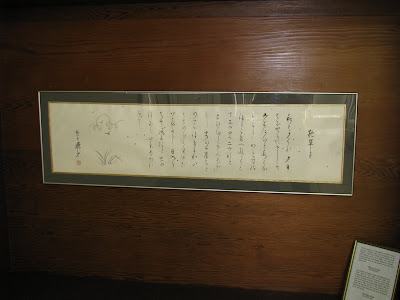



The images above are an example of Hiseki Davey's kana style calligraphy. Davey Sensei holds the highest rank in Ranseki Sho Juku calligraphy, and he is a direct student of Kobara Ranseki Sensei, the famed founder of this discipline.
Kana are the phonetic symbols of Japan, and they are typically brushed in a flowing and cursive script. In the artwork above, Davey Sensei included some sosho kanji, Chinese characters painted in an abstracted and cursive form, a script that flows into the equally gentle and rounded kana.
The calligraphy was painted on a large piece of colored handmade Japanese paper, specially designed for kana brush writing, and incorporating small flecks of gold, silver, and other elements. Davey Sensei also executed a simple and somewhat abstract ink painting that illustrates the autumn clouds, birds, and tall grass referenced in the writing.
The calligraphy reads:
In autumn evenings, when the glittering sun sinks close to the edge of the hills, the mountain trees seem so very near. Crows sing as they fly back to their nests in threes and fours and twos; more charming still is a file of wild geese, like specks in the distant sky. When the sun has set, one's heart is moved by the sound of the wind and the hum of insects in the tall grass.
Sei Shonagon
Makura no Soshi--The Pillow Book
This graceful example of Davey Sensei's art appeared in the Kokusai Shodo Ten, where it won a top award. The Kokusai Shodo Ten is an annual international exhibition of Japanese calligraphy. It takes place in Japan, and it has been called "the Olympics of shodo."
Hiseki Davey Sensei, is known throughout the world as the acclaimed author H. E. Davey, the creator of Brush Meditation, Living the Japanese Arts & Ways, The Japanese Way of the Artist, and other works. Davey Sensei can be commissioned to create distinctive works of calligraphic art similar to the one above for your home, office, or commercial use. He can be contacted at hedavey@aol.com or reached by telephone at 510-526-7518.





















